Family : Monacanthidae

Text © Giuseppe Mazza

English translation by Mario Beltramini
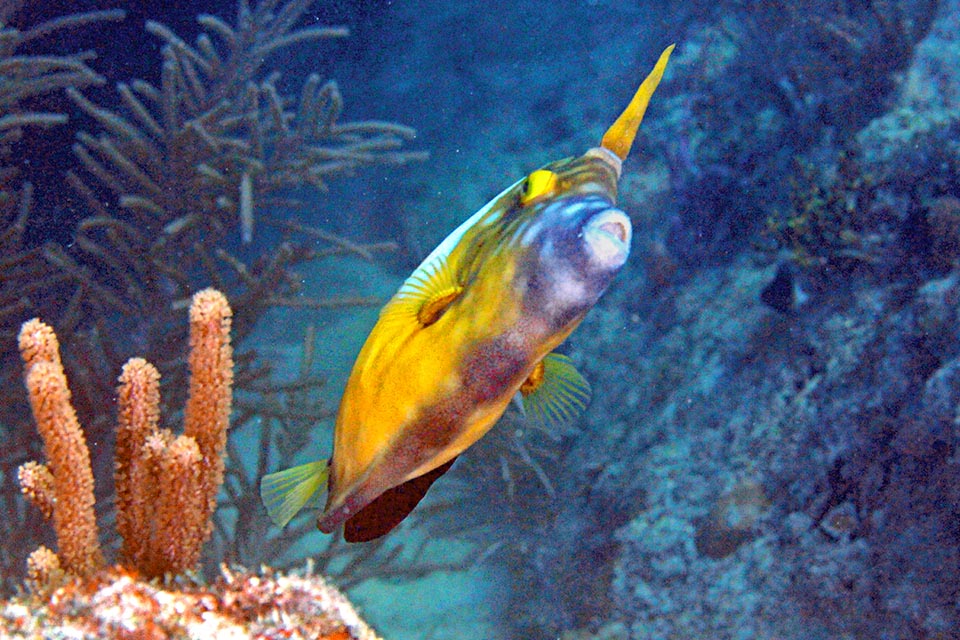
Cantherhines macrocerus is present on both tropical Atlantic coasts but mainly in America with epicenter in the Caribbean © Kevin Bryant
Cantherhines macrocerus (Hollard, 1853), known as American whitespotted filefish, belongs to the class of the Actinopterygii, the ray-finned fishes, to the order of the Tetraodontiformes and to the family of the Monacanthidae, that counts nowadays 27 genera and more than one hundred species with a dozen of them placed into the genus Cantherhines of doubious etymology.
In fact, the Author does not say anything and the interpretations do not agree. Cantherhines could have originated from the Greek “kanthos”, corner of the eye, and “rhinos”, nose, with reference to the showy spine located perpendicular to the eye like a nose; but others talk, always in Greek, of “[a]canthus”, spine, and “rhine”, rasp, with reference to the skin covered by small bony plaques with tiny spaced spinules, used time ago for smoothing artifacts.
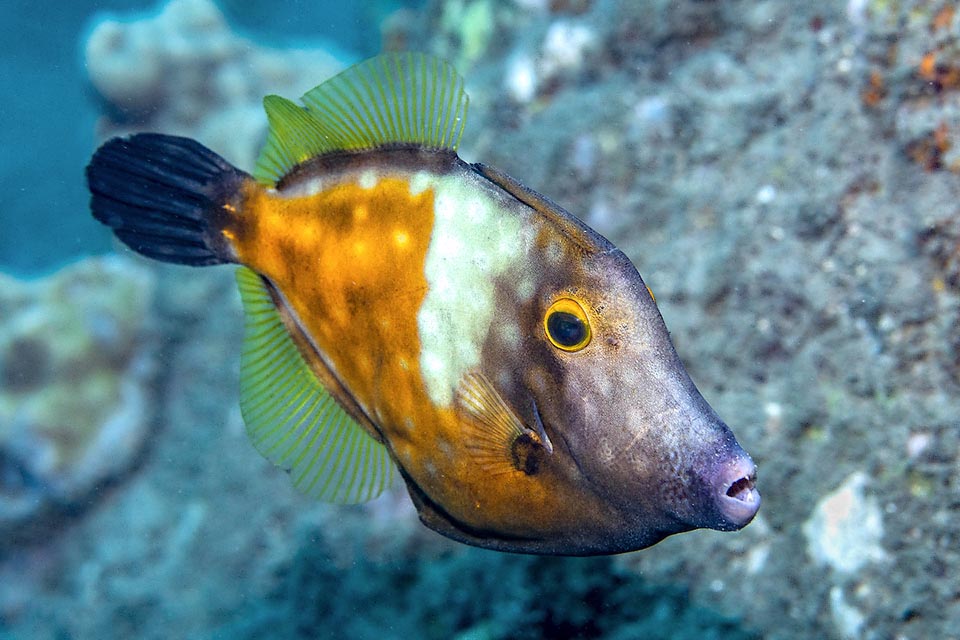
It’s a filefish, so called due to the skin covered by tiny bony plaques with minute spaced spinules, yore used for levigating the artifacts © Allison & Carlos Estape
The specific term macrocerus evokes, too, the big spine, utilizing in one single word composed by the Greek “makro”, big, and “keros”, horn.
Zoogeography
Cantherhines macrocerus lives mainly in the western Atlantic, from the Bermudas to Florida and the Caribbean up to Brazil.
Then we find it eastwards at the St. Peter and St. Paul Archipelago, at Ascension Island and on the African coasts in Sierra Leone.
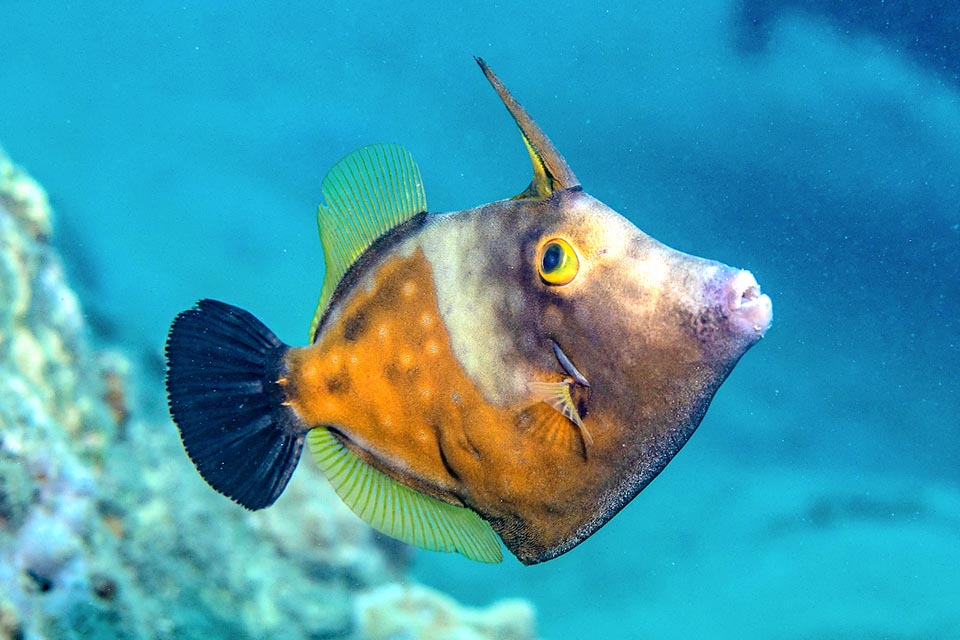
It has a long defensive spine over the eyes. Lockable vertically, remains as such even if the fish dies deterring predators with delicate stomachs © Allison & Carlos Estape
Recently, an opus concerning its presence at Principe Island in the Gulf of Guinea has been published and there have been reported sightings in the Cape Verde Archipelago and in the Canary Islands.
Ecology-Habitat
The American whitespotted filefish usually goes swimming among gorgonians and sponges from 2 to 40 m of depth, in the madreporic or rocky formations rich in ravines where it is easy to camouflage and to get a hideaway.
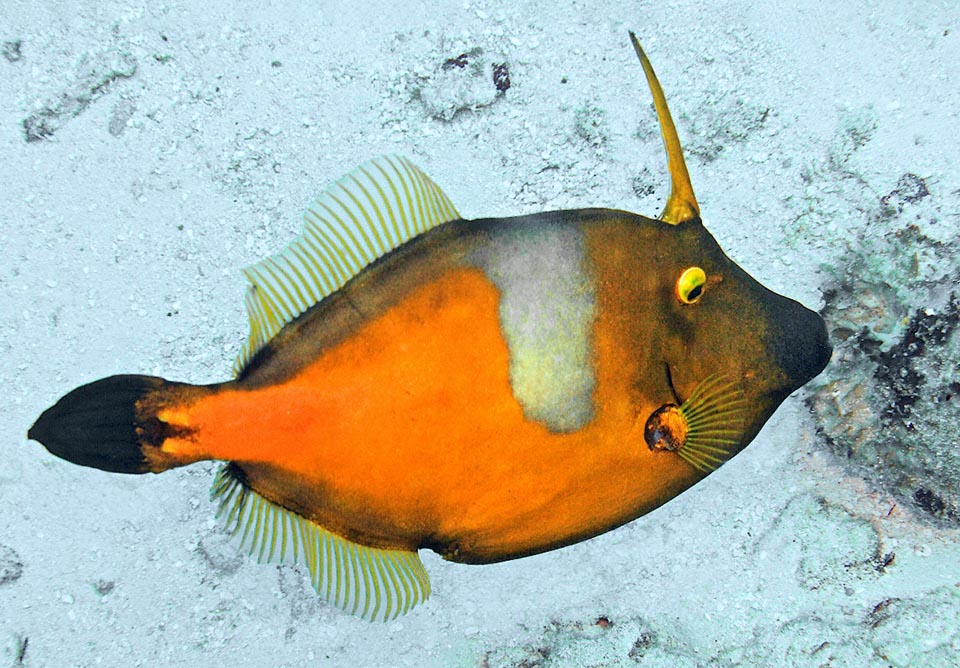
It has two liveries and can switch from one to other in a few seconds. This is the orange one, characterized by a wide saddle shaped clear band on the sides. © Allison & Carlos Estape
Morphophysiology
Cantherhines macrocerus usually measures 35 cm but may even reach 45 cm.
As is the case of the triggerfishes (for instance, Pseudobalistes fuscus), thanks to a locking mechanism, the first spine of the dorsal may be locked vertically by the second, almost invisible, and remain as such even if the fish passes away. A sort of a warning dagger that the fish raises when disturbed, ready to wound, if swallowed, the voracious predators.
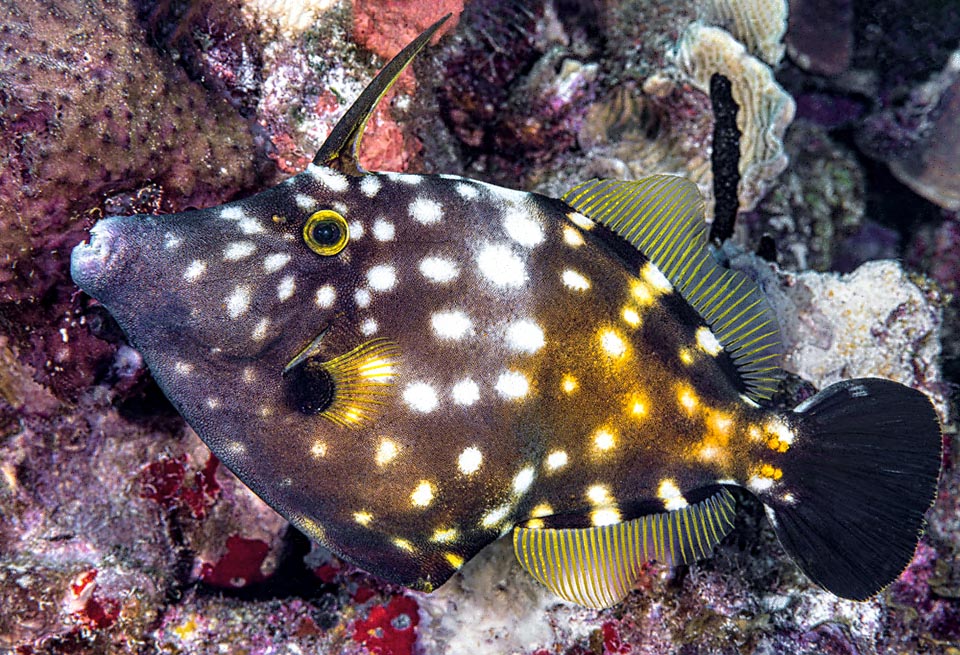
Conversely, this is the spotted livery that has originated the common name of American whitespotted filefish © François Libert
The second dorsal fin has 34-36 unarmed rays, like those of the anal, that counts 29-32 soft rays, and of the pectoral ones that have 13-14 rays.
There are no pelvic fins but the belly may extend downwards in order to appear bigger at the eyes of the aggressors, like, for instance, Acreichthys tomentosus who belongs to the same family.
As often occurs in the world of fishes, the livery may change depending on the mood and the mimetic necessities.
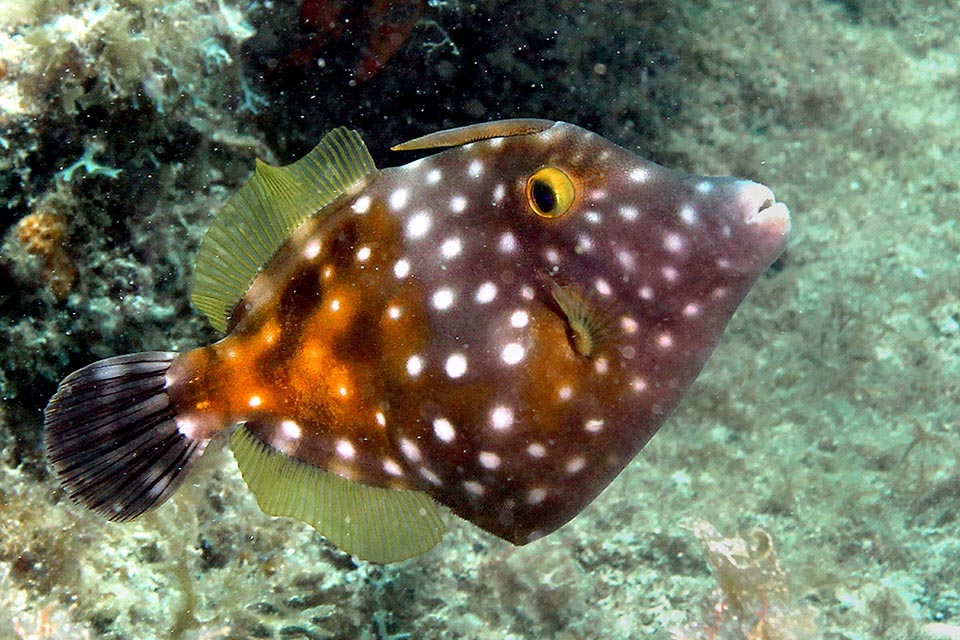
The two liveries can merge increasing the mimetic effect. To note the belly, expandable with tip at bottom, to make fish look bigger and so less swallowable © Kevin Bryant
Cantherhines macrocerus has substantially two of them on which it plays skillfully in crossfades. The first has an orange brown background with a wide saddle-like clear or grey band on the sides just before the second dorsal fin. The second is much darker, dotted with showy white spots, perhaps a legacy of the juvenile black with small white spots livery.
Accentuating the two in turn they appear for then disappearing in a few instants incredible camouflage light effects and it has been noted that when swimming in couples the two almost have a different colour phase. Perhaps the spotted livery, reminiscent of childhood, is an act of submission to the partner.
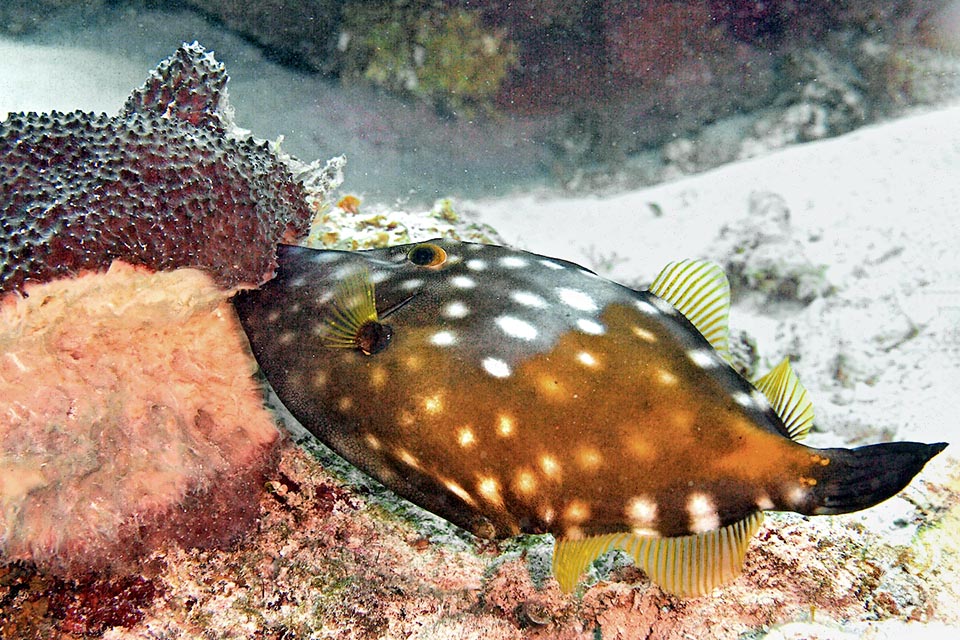
Cantherhines macrocerus is an omnivorous species. It eats algae but also, like here, sponges. Doesn’t ignore hydroids and also devours the stinging coral polyps © Allison & Carlos Estape
The second dorsal fin and the anal one are almost transparent. The first caudal is substantially black with paler rays, and on the two sides of the peduncle we note two pairs of range spines, well visible, as a clear warning to the aggressors, king of like they do with the showy case of their sharp blade the Acanthuridae, known for wounding with tail lashes the aggressors, and in particular among the latter Naso elegans who displays flaunts showy scalpels shaped like a claw of flame red colour.
In the males of Cantherhines macrocerus these defensive spines are more developed, preceded by orange bristles, and form the only evident dimorphism.
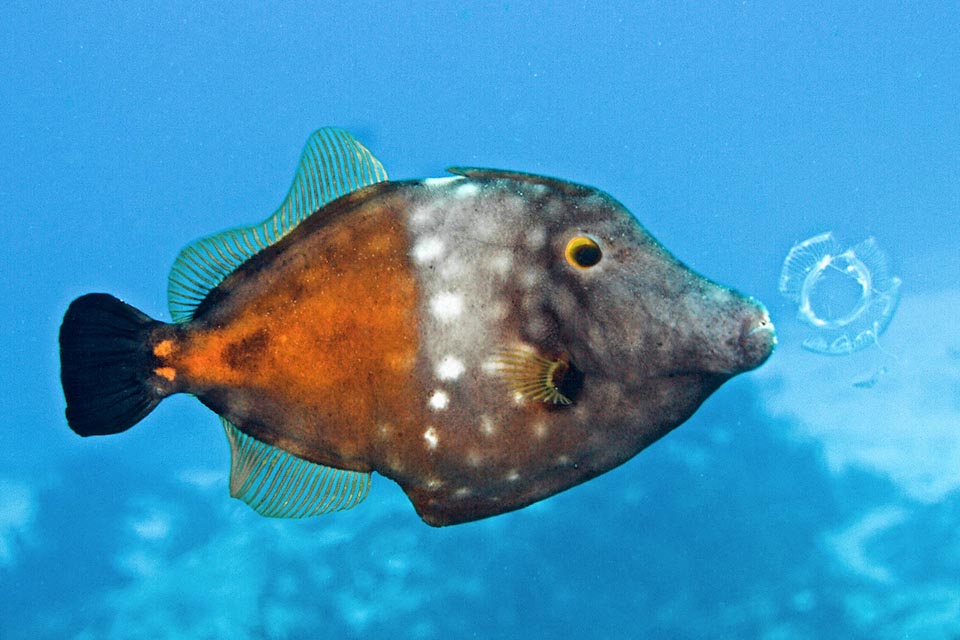
Here it bit a small jellyfish and we recognize the two superimposed liveries © Allison & Carlos Estape
The eye is surrounded by a bright yellow-orange ring, the small gill opening, oblique, is poorly visible, and the snout is elongated for rummaging into the ravines, has 6 solid teeth on the upper jaw and as many, or less, in the lower one.
Ethology-Reproductive Biology
Cantherhines macrocerus is an omnivorous species. It nourishes of algae but mainly of sponges and hydroids, and beyond the gorgonians’ polyps, it eats greedily, with indifference, also those of the stinging corals.
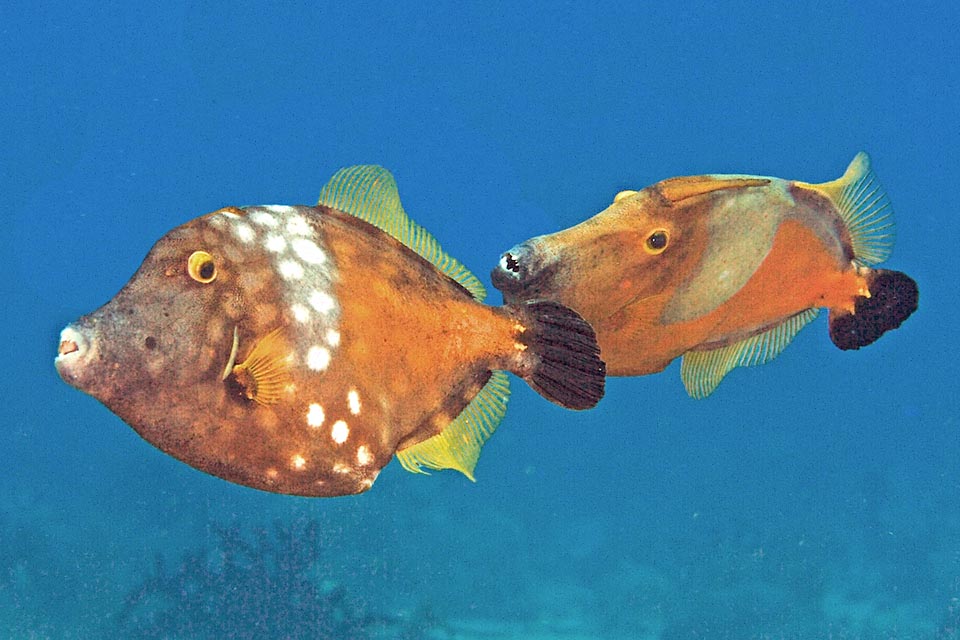
A couple. The male, right, is at once recognized by the bigger defensive spines on the caudal peduncle, preceded by orange bristles. This is the only evident dimorphism © Allison & Carlos Estape
The eggs are laid on the seabed in a safe place, in a small nest often located in a depression of the sand, with the parents keeping watch until they hatch.
The eggs and the young are pelagic.
Highly preyed upon, they often grow hidden under floating wrecks carried by the currents or the friendly ramifications of the sargassoes that bring them to distant beaches.
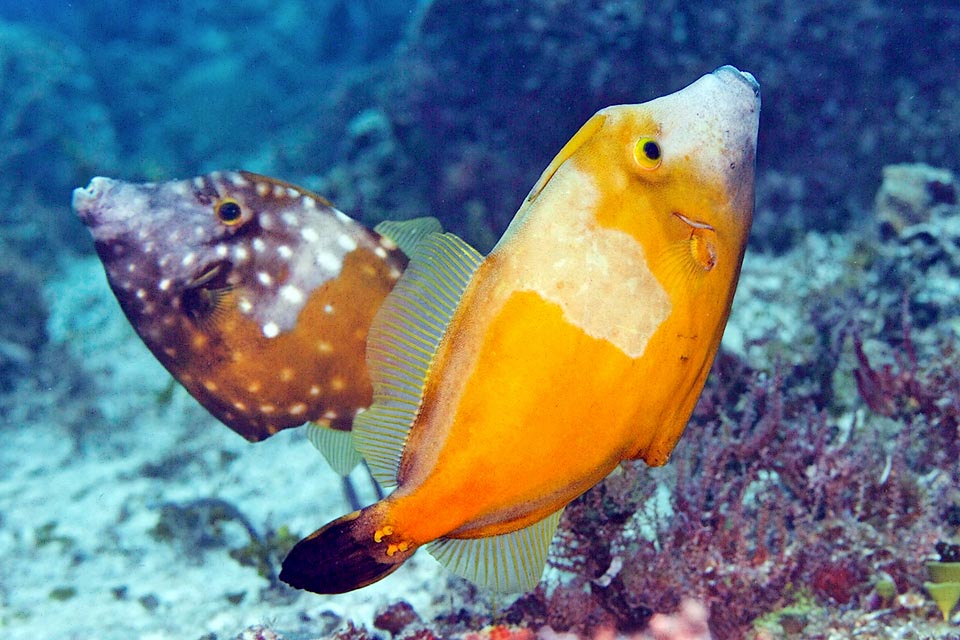
The eggs are laid in a bottom depression and parents keep watch until they hatch. Larvae and young are pelagic. They often grow hidden among the drifting ramifications of sargassoes or under floating objects that carry them towards far away beaches. And perhaps it’s how they reached over time the African coasts © Allison & Carlos Estape
The resilience of the species is mediocre, as 1,4-4,4 years are needed for doubling the populations and the moderate fishing vulnerability marks 36 on a scale of 100. Cantherhines macrocerus appears in the IUCN Red List of the endangered species as “Least Concern”, that means, “Minimal Concern”.
Synonyms
Monacanthus macrocerus Hollard, 1853, Cantherhines macroceros (Hollard, 1853).
→ For general information about FISH please click here.
→ For general information about BONY FISH please click here
→ For general information about CARTILAGINOUS FISH please click here.
→ To appreciate the BIODIVERSITY of BONY FISH please click here.
→ To appreciate the BIODIVERSITY of CARTILAGINOUS FISH please click here.
